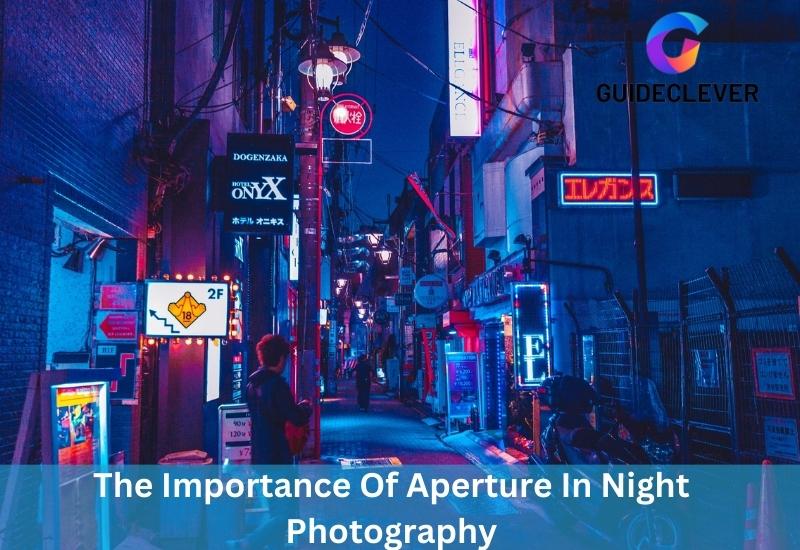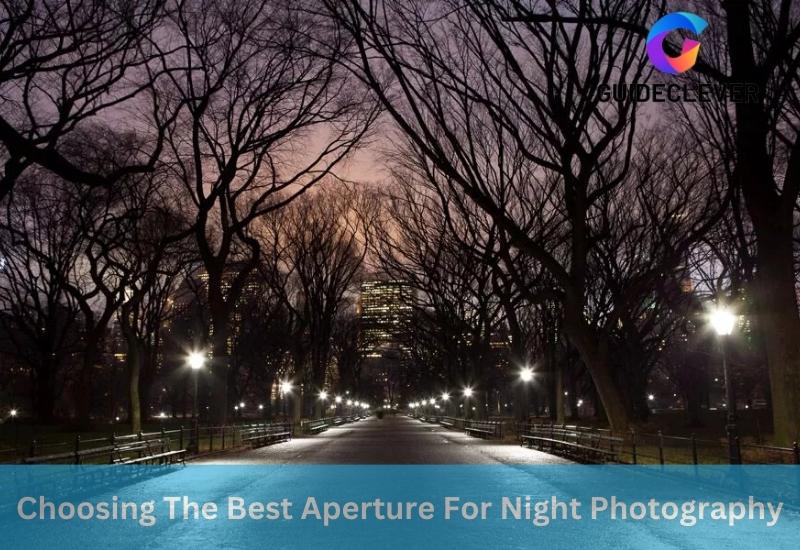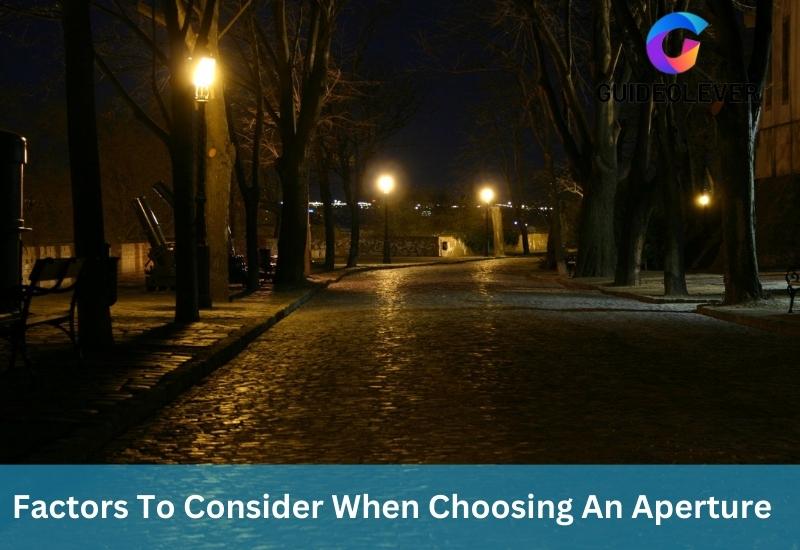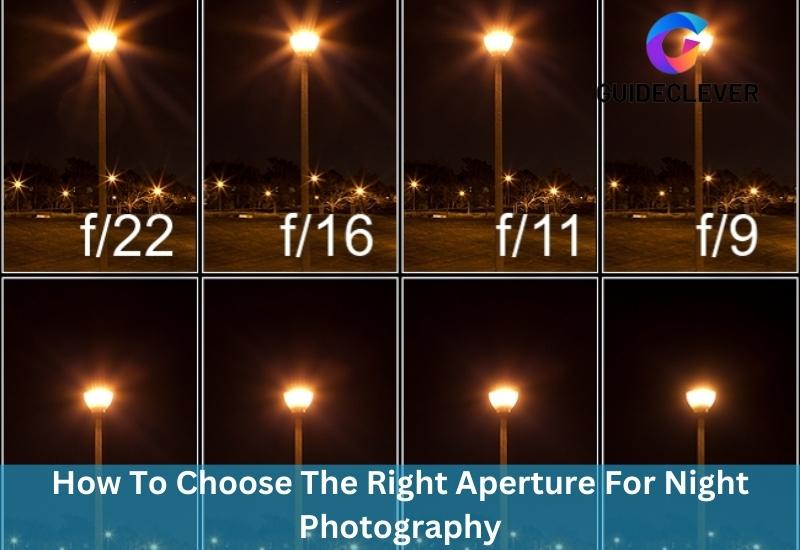Photography, in its essence, is the art of capturing light. Night photography adds a new dimension to this fundamental principle. Photographers must learn how to choose the right aperture for night.
Choosing the correct aperture is crucial for night photos. It affects exposure, depth of field, and overall impact. The balance of light and your creative vision affects your camera’s sensor.
Understanding the nuances of aperture selection in night photography is akin to unlocking the secrets of the night sky, cityscapes, and low-light environments. Let’s learn how to take photos at night. We’ll also learn how to choose the right aperture for beautiful nighttime shots.
Contents
- 1 Definition And Explanation Of Aperture
- 2 Best Aperture for Night Photography with the Reasons
- 3 The Importance Of Aperture In Night Photography
- 4 How Aperture Affects Depth Of Field?
- 5 Aperture And Its Relationship To Night Photography
- 6 Choosing the Best Aperture for Night Photography
- 7 Which Is The Right Aperture For Night Photography?
- 8 Factors To Consider When Choosing An Aperture
- 9 Final Thoughts On Mastering Night Photography With Aperture
Definition And Explanation Of Aperture
Aperture is essential for controlling how much light enters the camera. The part of the lens through which light can pass is called the aperture. The width of the aperture determines how much light can enter. The resulting image will be brighter and more defined.
This will help if you use it when taking night photos. Aperture is very important for photography. Now this importance are explained below
Best Aperture for Night Photography with the Reasons
Here’s a table about the right aperture for night photography along with the reasons for using each aperture setting:
| Best Aperture For Night | Why Use This Aperture |
|---|---|
| Wide Open (Low f-number) | – Allows more light to enter the camera, ideal for capturing stars, cityscapes, and other low-light scenes. – Creates a shallow depth of field, which can be used creatively for selective focus on specific subjects. – Useful for astrophotography to capture the night sky with pinpoint stars. |
| F/2.8 to F/4 | – Balances good light intake with some depth of field, suitable for general night scenes and cityscapes. – Helps maintain sharpness in both foreground and background, ensuring more of the scene is in focus. – Reduces the risk of lens aberrations and artifacts. |
| F/5.6 to F/8 | – Provides a deeper depth of field, suitable for capturing landscapes, architecture, and cityscapes. – Allows for longer exposure times without overexposing bright lights in the frame. – Ideal for achieving a balance between subject and background focus. |
| Narrow (High f-number) | – Useful for extremely long exposures or specific creative effects like light trails or starbursts. – Reduces the amount of light entering the camera, helpful in preventing overexposure in well-lit areas. – Requires a stable tripod and potentially higher ISO settings for proper exposure. |
Please note that the right aperture for night photography can vary based on your specific subject, creative goals, and available equipment. Experimentation and adjusting the aperture according to your needs will help you achieve the desired results in your night photography.
The Importance Of Aperture In Night Photography

The aperture is crucial in night photography. You may change the lights in this way. Here are a few things to consider when choosing the right aperture for your night photos:
- 1. The larger the aperture, the more light will enter. It is perfect for low-light situations. This will allow you to capture more light and detail in your images.
- 2. A smaller aperture will reduce the light entering the lens. This will make the image darker. This can be useful to create a dramatic effect or blur background elements.
- 3. Aperture also affects how in focus (depth of field) your image is. A shallower depth of field will result from a bigger aperture. Only this will keep your focus on your main point. A smaller aperture will produce more of the image in focus resulting in a greater depth of field.
- 4. Choosing the right aperture for night photography can also help you create starburst and light streak effects.
- 5. When shooting cityscapes, a large aperture can help you capture all the details of the scene.
- 6. A smaller aperture will help reduce the light entering the lens if you shoot indoors or in a dark environment. Your image will have less noise as a result.
- 7. Choosing a wide aperture can create interesting bokeh effects. It can add a dreamy look to your night photos.
- 8. The clarity of an image can also be impacted by aperture. A larger aperture (smaller f-stop number) will produce crisper and sharper images. A narrower aperture (larger f-stop number) will produce softer and less focused images.
How Aperture Affects Depth Of Field?
Depth of field is another important aspect of aperture. The amount of your photo that is sharp from front to back is known as depth of field. In some images, the backdrop is out of focus due to “thin” or “shallow” depth of field.
Other photographs have a “large” or “high” depth of field, where the backdrop and foreground are sharply defined. Aperture is closely related to photographs. You will know about them below
Aperture And Its Relationship To Night Photography
More light will enter the space if the aperture is larger. This can be handy for night photography. This will result in a brighter image with more detail due to increased depth of field (DOF).
Increased depth of field (DOF) focuses on foreground and background elements. Allows all the important elements to come together in one shot. Aperture will make the night sky more distinct. Its dark colors are intensified by increased light.
This is important to remember when choosing an aperture for night photography. If you increase your aperture too high, your photo may be overexposed. As a result, it can be washed away. You need to have enough light to make a good photograph. Here is an explanation of the types of apertures with photographs and what you need to know to choose them
Choosing the Best Aperture for Night Photography

01. Wide Aperture (F/1.4 – F/2.8)
A wide aperture is helpful for night photography to capture a subject in low light. This is extremely helpful when distinguishing the subject from the background.
Pros
- As a result, more light is let into the camera.
- This is essential for night photography
- A shallow depth of field enables the subject to stand out from the background.
- It can provide a stunning bokeh effect.
Cons
- Careful focusing is required as a wide aperture can provide a shallow depth of field
- This makes achieving fine focus challenging.
- In certain lighting conditions, this can lead to overexposure or blown-out highlights.
- Using expensive lenses with large apertures may be necessary for the desired results.
02. Medium Aperture (F/4 – F/8)
A medium aperture is ideal for photographing a subject with a greater depth of field at night. This is helpful when taking cityscape or landscape photos.
Pros
- Widens the field depth, making obtaining sharp focus over the entire image simpler.
- Compared to lenses with wide apertures, cheaper lenses can be used.
- Can create photographs that are crisp and detailed.
Cons
- A longer exposure time may be required than using a wider aperture.
- Makes hand-holding the camera more challenging.
03. Narrow Aperture (F/11 – F/16)
A narrow aperture is perfect for night photography. As a result, you can photograph a subject with a greater depth of field. It is useful for photographing cityscapes, landscapes or architecture. This allows you to maintain a sharp focus on the entire scene, foreground to background.
Pros
- Broad field depth is possible, making obtaining sharp focus over the entire image simpler.
- Reduces the amount of light entering the camera
- It makes it easy to expose images for longer periods without overexposing them.
- Can create photos with amazing detail and sharpness.
Cons
- This makes hand-holding the camera more challenging.
- Using a tripod or another stabilizing tool can be necessary.
- The bokeh effect might not be as strong as with a wide aperture.
Which Is The Right Aperture For Night Photography?
- There is no “correct” aperture for night photography. It depends on the specific situation.
- A wide aperture (f/1.4 – f/2.8) may be appropriate to separate your subject from the background.
- A medium (f/4 – f/8) or narrow (f/11 – f/16) aperture may be more appropriate if you want to focus everything in the field.
Ultimately, the choice of the aperture will depend on the lighting conditions, the type of subject and the desired result. It is important to experiment with different apertures.
Factors To Consider When Choosing An Aperture

Some important factors to consider when choosing an aperture for night photography include:
1. The type of lens you are using
Different lenses have different maximum apertures. Choosing one that will allow enough light for your shots is important.
2. Scene composition
A wide aperture can be used to blur the background. It can draw more attention to the main subject in the shot. A narrower aperture will produce sharpness throughout the frame if you shoot a landscape or wide-angle scene.
3. Your camera’s ISO settings
The higher the ISO, the brighter your image will be. More light will enter through the lens. It is important to ensure you are not overexposing the image by selecting a too-wide aperture.
Final Thoughts On Mastering Night Photography With Aperture
We learn about night photography and aperture. Choosing the right aperture is both technical and artistic. At night, photography has endless possibilities. Light and shadow dance together, creating a beautiful tapestry.
Now you know that a big camera hole lets the universe in, making pretty stars and cityscapes. You understand how mid-range apertures combine sharpness with the beauty of the night. You have discovered the wonders of small openings in cameras. They create beautiful photos with long exposure and special effects.
The right aperture is your key to unlocking the secrets of the night, but it’s only the beginning. Night photography demands patience, experimentation, and an intimate understanding of your camera’s settings. As you continue to explore the night, remember that each scene and each moment under the stars is unique. Adjust your camera settings to match the mood of the story and let your imagination shine.
Explore the magical world that appears at night by going out with your camera set correctly. In the realm of night photography, the canvas is yours, and the stars are your brushstrokes. Light up the night and may your photos capture the wonder and magic of the night.



3 thoughts on “How to Choose the Right Aperture for Night: Finding Your Focus!”